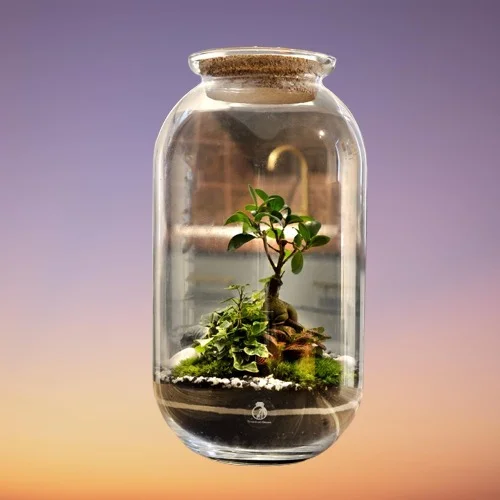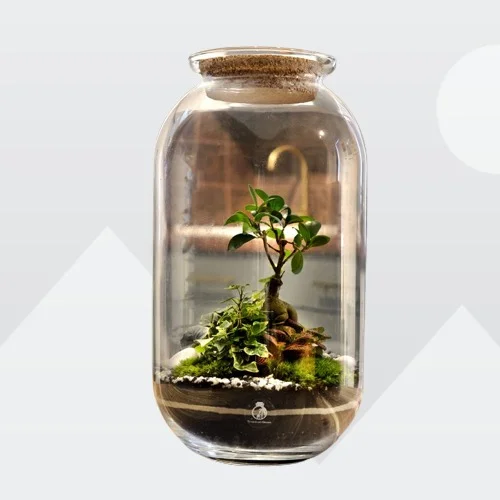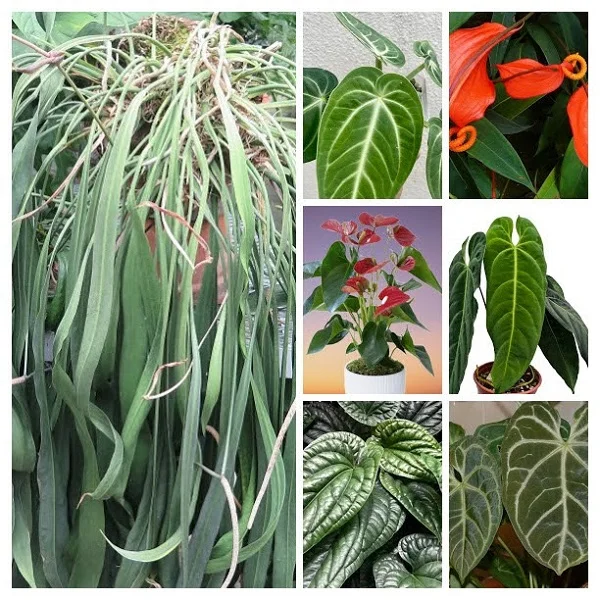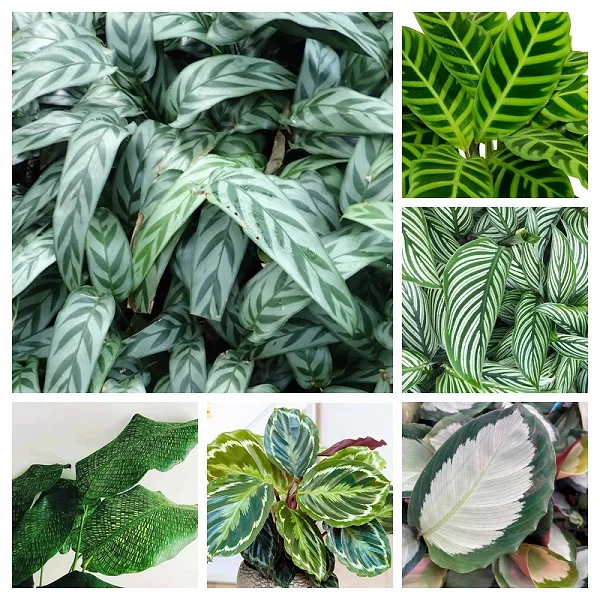How to Make a Closed Terrarium for Houseplants
Some links in this post may be affiliate links
A terrarium is one interesting way of displaying houseplants. A terrarium is a glass or transparent container inside which plants are grown.
The terrarium completely or almost completely surrounds the houseplants and as a result keeps off the plant-killing drafts.
The air within a terrarium is always moister than the room atmosphere which makes it ideal for growing the delicate plants that may require high humidity and protection from drafts.

A terrarium is one of the best methods by which you can display the moisture-loving plants as a high humidity can be maintained in a terrarium.
Some containers that are ideal for a terrarium include a fish tank, a large bottle or even a large mixing bowl.
The only requirement is to have transparent sides and a restricted opening or an opening that can be covered with a transparent material. There are many types of beautiful terrariums to choose from.
Buy beautiful terrariums online from Amazon
Types of Terrariums for Growing Plants
There are two types of terrariums for growing houseplants; closed terrariums and open terrariums.
1. Closed Terrarium
This type of terrarium is completely sealed. There is no interaction of the air inside with air outside the terrarium.
How does a closed terrarium work?
Closed terrariums create their own unique ecosystem for plant growth. The transparent walls allow both heat and light to enter the terrarium.
The light allows the plants to photosynthesize resulting in production of water and oxygen.
The heat causes the water so produced in addition to water present in the soil to evaporate and condense on the walls of the terrarium, which then falls on the plants and the soil.
This provides water for the plants and therefore this type of terrarium rarely requires watering.
The oxygen produced during photosynthesis is used by the plants during the process of respiration which produces carbon dioxide that is needed for photosynthesis and the cycle continues.
A closed terrarium is ideal for tropical plants which require humid and sheltered environments which mimicks their native tropical climate.
2. Open terrarium
An open terrarium is one whose top or one side is open. This allows interaction of air inside with air outside the terrarium.
The open terrariums are suited to plants that require dry conditions like Desert Cacti and Succulents.
Closed terrarium layers: A step by step process
To ensure that your terrarium is a good place for your plants to grow and thrive, it needs to have good drainage, a healthy environment and a good growing medium.
At least six layers of material are required to achieve these. Here is a step-by-step process of preparing a terrarium.
1. Drainage Layer
The drainage layer is the first layer at the bottom of the terrarium. It helps in keeping the growing medium well-drained and prevents waterlogging of the soil. This layer should be at least 2 inch deep.
Various materials can be used to make this layer like gravel, small river rocks, decorative stones, sea glass and marbles.
Do not use LECA for a closed terrarium as it tends to produce a lot of gas.
2. Moss Layer
The Moss Layer is for holding the soil in place to prevent it from getting to the drainage layer and reducing its efficiency. This layer should be thick enough to hold the soil in place.
3. Charcoal Layer
A charcoal layer of about 0.5 in. thickness is necessary for a healthy terrarium.
Charcoal acts as a filter to remove toxins and prevents growth of bacteria and fungi which can cause odor in the terrarium. It keeps the terrarium fresh.
4. Soil Layer
The soil layer provides anchorage for the plants roots and supplies nutrients to the plant.
Ensure the soil is free-draining to avoid soggy soil. This layer should be at least 2.5 in. thick, enough to serve the purposes above.
5. Plants Layer
Select a variety of plants that vary in height, growth habits and texture in order to have an interesting landscape.
Select houseplants that have close or similar light requirements. Here are some examples of plants that are ideal for a closed terrarium.
It is advisable to avoid flowering houseplants for the following reasons;
(a) Flowering plants have different light requirements through out the year.
(b) It will be difficult to remove dead flowers especially in a closed terrarium.
(c) Most flowers require good air circulation in order to prevent powdery mildew and fungal infestations.
How to prepare plants for a terrarium
Prepare the plants by pinching off the growing tips and prune tall and spreading types to minimize their size.
Trim long roots for ease of planting and remove dead and yellow foliage.
Check the plants for pest and disease infestation; do not use any infested plant as using them will introduce these infestations in the terrarium environment where they can be difficult to control.
How to plant the plants in a terrarium
To plant, make a hole in the soil with a stick, insert the plant roots in the hole and lightly firm the soil around the roots.
Start by planting the tall plants to the back of the terrarium and move towards the front with shorter plants. Include a ground cover that will eventually cover the empty spaces.
6. Decorative Layer
The decorative layer is simply for decoration purposes. Use what you like to decorate your terrarium.
Good examples of decorative material are colored pebbles, sea shells, glass beads, figurines and others.
Any inert material can be used for decoration. Avoid wood as it can become moldy and thus affect the environment in the terrarium.
How to care for a plants terrarium
There are two major considerations in taking care of a plants terrarium. These are water and light for the terrarium.
How to water a closed terrarium
Ensure the soil is moist at all times but water sparingly. In most cases if the terrarium is well covered, watering will not be necessary as there is minimal evaporation and the plants form their own ecosystem inside the terrarium.
If there is condensation on the inside of the glass soon after planting, open the terrarium to allow excess moisture to evaporate.
Light for a closed terrarium
Place the terrarium in a bright spot but away from direct sunshine to avoid cooking the houseplants. Plants in a terrarium can also thrive under grow lights (artificial light).


